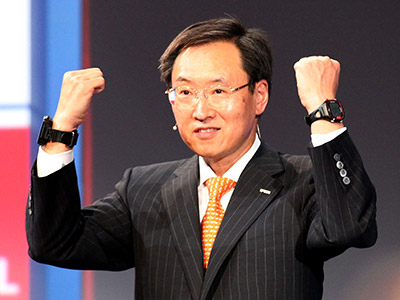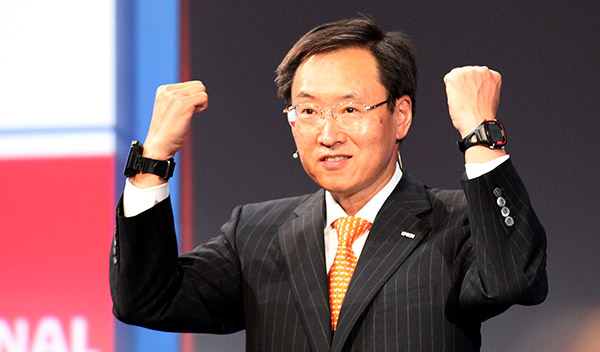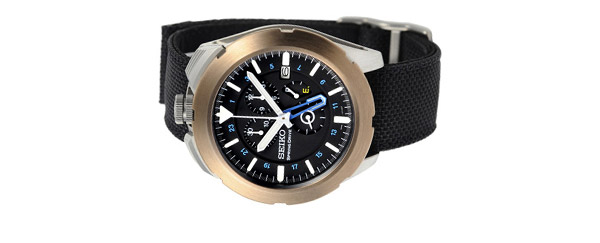Why Epson Is the Wearables Brand to Watch
While Epson is known for printers, it's carving out a niche in the wearables space by focusing on accuracy.


History will note that during the second decade of the 21st century, we became obsessed with measuring every step we took, every droplet of sweat, every beat of our hearts, every moment of sleep, every calorie of food consumed. And that's just for starters.
History will also remark on the thousands of new companies, born in what seems like an instant, making the sensors and the wristbands and the glasses and the clothes to measure all these things — and, again, that barely scratches the surface. Nearly everything we have will soon measure nearly everything we do.
Undoubtedly, history will also look forlornly at a graveyard of failed ideas and companies, but now we're getting a bit ahead of ourselves.
MORE: Will Wearables Replace Your Smartphone?
Where, then, among the oh-so-many others, will we place Epson, which announced a series of wearables this year at CES? Or perhaps put differently, why Epson, maker of ink-jet printers and conference room projectors?
The answer lies in the history of this Japanese company, founded in 1942, and known globally as the corporate entity called Seiko Epson. Yes, that Seiko, the one long known for its watches. Also the Seiko Epson that makes quartz crystal, and now the company is shifting more of its R&D into making standout wearable devices, namely those that offer a level of precision and accuracy usually associated with timekeeping devices. The company also owns its entire assembly line, giving it more say into every component that goes into its devices.
Epson President and CEO Minoru Usui believes that his company will separate itself, and its wearables, by clinging to just that philosophy, and the technology know-how that no other company in the world can match. Usui talked to Tom's Hardware and Tom's Guide for nearly an hour about Epson's newest products, and the technology that fuels them.
Get instant access to breaking news, the hottest reviews, great deals and helpful tips.
Later, we took a trip to Epson's U.S. headquarters in Long Beach, California, to see some of the products in action and to get some further information from Randy Bergstedt, manager of Epson Active.
Precision, Powered by Its Own Quartz
How accurate, really, is the heart-rate sensor on your fitness-tracking wristband? Does your watch's pedometer accurately count your number of steps like a real pedometer? In a sea of wearables that have what Usui characterized as generic, semi-accurate, second-rate sensors, his company wants to stand out by offering what he said is unmatchable precision.
MORE: Fitness Tracker Buying Guide
There's a market for accuracy. Serious athletes need to know they can depend on their trackers for dependable feedback, as do the health care and infrastructure industries, which use sensors in maintenance and preventive equipment.
"We're trying to address the question, 'How do you get as close to the real thing as possible?'" said Usui.
To deduce the exact state of something, you need better components, and Epson can offer premium components created for these markets, said Usui.
The company's secret weapon? Homegrown quartz crystals, which have powered Epson Seiko's timepieces for decades. In its two farms in Japan and Seattle, Epson grows its own artificial quartz in tanks to use in these sensors. Usui said that artificial quartz is more pure. The company makes its sensors in Japan, and final product assembly takes place in Malaysia.
Cost isn't a significant reason for the company to farm its own material. Usui said the amount of crystal needed to make sensors in wearables is very small, and the material cost is low. The primary reason for the homegrown quartz is precision.
Usui said that he wasn't aware of any other company doing this, or owning the entire manufacturing process from raw materials to final assembly. And because Epson has been doing so for such a long time, he said, the barrier to compete on this basis was high — "virtually impossible" to overcome, he said.
We reached out to a few independent sources familiar with sensor engineering, but none of them could verify or refute any claims about enhanced accuracy due to the use of homegrown quartz.

The company is betting that its commitment to precision will allow it to dominate industries in ways others cannot. Its $129 Pulsense product, for example, measures heart rate by sensing blood flow. The company's M-Tracer ($279), which you can attach to a golf club, contains three precise gyros that can measure not just swing velocity, but also the angle of the club face on the ball. "If you're a really serious athlete," Usui said, "if you want to know the exact state of your body, off-the-shelf components aren't really good enough."

Each Epson product uses different sensors. The M-Tracer, for example, uses IMUs (inertial measurement units) that are calibrated with special equipment. It can detect where it sits on the club and the force of gravity, and can handle swing speeds of 130 mph. Bergstedt said that Epson delivers, in this nearly $300 product, what's normally reserved for a $25,000 TrackMan — a radar-based unit that many golf teaching pros and club fitters would use. You can see some of the results in the short video demonstration at the top of this story (the video doesn’t include one of the authors' miserable golf swings).
The Pulsense fitness bands and watches do more than just count steps. They also measure stride and register the intensity of parts of the workout (for example, how much time you spent in a particular heart rate zone). You can see a demonstration of some of these features in the second video above.
Usui said that Epson's sensors are not only accurate, but also energy efficient. The Epson Runsense, which uses GPS sensors, can operate for 30 hours continuously without a charge, he said.
Other sports on the horizon for Epson include tennis, baseball and any others that require measurement of motion.
Putting Money Where Its Mouth Is
To power its march toward military precision, the company is investing heavily into research and development. Usui said that Epson spends about 5 percent of its approximately $10 billion revenue on R&D, and $50 million of that will be poured into wearables (more than 10 percent of the R&D fund by our calculations).
Usui said Epson expects wearables to be a $100 million business in three years, and $200 million in five years. While that might be a fairly small revenue for a company of Epson's size, Usui was quick to point out that the size of the wearable market was still quite small.
Usui also noted that Epson's watch and watch movement business is about $500 million, so wearables will soon be a significant part of that overall business if Usui's predictions are on target.
Epson, which has a sizable commercial business, isn't just targeting consumers. Usui mentioned that precision healthcare is an area the company is investigating, along with the industrial market. For example, building, road and bridge construction could benefit from Epson's sensors, he said, which could tell cities and building owners when their structures are changing shape and susceptible to damage, allowing those entities to make fixes before such damage occurs.

Software: Work in Progress
With its expertise in hardware, Epson's most daunting task is coming up with great software for its products. When asked about the Apple Watch, Usui said his company's high-quality hardware will set it apart, but acknowledged that Apple has a core advantage: apps.
Usui told us that Epson is working on its software "and can realize it over time," but didn't share specifics on what the company was doing. Still, he said, "while Apple is coming at it [the wearables market] from a software point of view, we are coming at it from a hardware point of view."
Epson's Bergstedt said that the company's wearable software is confined to a precise user experience focused on one particular use — the golfer is presented with the data and the tools to measure a swing, while serious runners learn whether they are overtrained, or how to improve their strides.
Make no mistake, while Epson's technology — like so many others — will benefit anyone who wants to be active, the company's target is the athlete. Bergstedt said the next measurement frontier will be heart rate variability. By tracking stress and fatigue, this measure gives an indication of how hard you're working, or "how your heart communicates what's going on in your body."
MORE: Everything You Need to Know About Apple Watch
At the moment, Epson's Runsense and Pulsense trackers employ simple operating systems with analog displays that come across as primitive compared with what we’ve seen of Apple's sleek, sophisticated wearable iOS. The Epson wearables provide basic features, displaying time, steps taken, pace and distance traveled.
Epson's Pulsense View app has a disappointing 2.5 out of 5 star rating on the Google Play store (as of Feb. 11, 2015), with most reviewers complaining about pairing issues. It received no rating on the iOS store due to a lack of reviews. Tom's Guide's fitness tracker specialist Valentina Palladino notes that Epson's app appears to have basic functions, and its predominantly gray color scheme is somewhat boring. Leading fitness monitor maker Jawbone has a more comprehensive app that offers tips to improve your workout.
Epson showed us the app for its M-Tracer golf sensor that was launched at CES 2015, which impressed us with its detailed analysis of each swing. It offers a replay of the swing comprehensive statistics on speed and direction, and a color scheme that ties in with its other apps, When we compared a video of Epson’s offering with an app by Zepp labs, which also makes a golf sensor, though, we preferred Zepp’s colorful layout and fun content. Zepp’s app lets you compare your swing to those of pros such as Keegan Bradley, Ryan Winther and Brendan Steele.
A Status Symbol
With its years of experience making watches, though, (Seiko) Epson has an edge on its competition. And the company wants to take things further by making sure its devices are status symbols.
"Just like in watches, accuracy is not enough," said Usui. "It's very much about design."

Since the company has already used premium materials, such as sapphire glass, in making some of the most stunning watches in the market, it's not a stretch for Epson to consider making luxury wearables.
But Epson doesn't plan to splurge on premium materials to give its products that sense of status.
Bergstedt was adamant that design doesn't equal fancy or luxury. "It's a different statement than a Rolex … You have to deliver a product people are really proud to wear."
In other words, Epson wants to create something that you want to own because wearing it tells people what you're about.
Seiko has a history of designing laudable products, having won many accolades and awards, such as Time magazine's design award in 2006 for the Spring Drive SNR005 and several "Watch of the Year" titles. These timepieces weren't praised so much for the materials used or level of luxury, but rather stood out for unique, almost futuristic technologies.
Seiko's Spring Drive Spacewalk watch turned heads as the first timepiece built to be worn during a spacewalk — and keep time in outer space. It features a ballistic nylon wristband made by the Russian Federal Space Agency, a GMT hand to keep track of Greenwich Mean Time and over 400 parts squeezed into a handsome device. Two of these timepieces made an actual trip to the International Space Station and a five-and-a-half-hour spacewalk, and continued to work well despite the extreme conditions.
It's feats like this that could make Epson's wearables must-have items. One of the Spacewalks that visited space was auctioned off in New York after its return for $45,000, far more than its $28,000 retail price.
Watch This Space
While it might sound like lofty talk and ambition, Epson has ingredients every other wearable maker lacks. It has a clear and differentiating focus; solid, relevant experience; formidable financial backing; and an awareness of its flaws. Epson is well-known, but it will need to convince consumers that it can compete and offer advantages in an incredibly crowded, but still nascent market. If the company delivers on the precision component front and improves its software, it could very well become the wearables brand to watch in 2015 - and if it does, be sure to check our Epson promo codes for a better price on your latest wearable device.
Staff Writer Cherlynn Low loves wearable devices. Follow her @cherlynnlow. Fritz Nelson is editor-in-chief of Tom's Hardware and Tom's IT Pro. Follow him @fnelson. Follow Tom's Guide at @tomsguide on Facebook.
Cherlynn is Deputy Editor, Reviews at Engadget and also leads the site's Google reporting. She graduated with a Master’s in Journalism from Columbia University before joining Tom's Guide and its sister site LaptopMag as a staff writer, where she covered wearables, cameras, laptops, computers and smartphones, among many other subjects.
-
g-unit1111 More Smartcrap we don't need, they should just save us the trouble and wire Facebook, Twitter and Instagram directly into our brains. :lol:Reply

